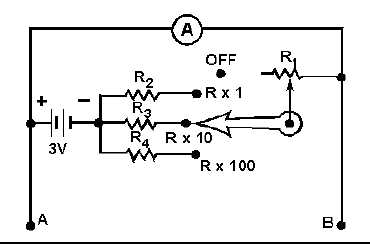1-37
. If a resistance is connected between points A and B, it shunts some of the current from the meter
movement and the meter movement reacts to this lower current. Since the scale of the meter is marked in
ohms, the resistance of the shunting resistor (between points A and B) is indicated. Notice that the switch
has an OFF position, as well as positions for R 1, R 10, and R 100. This is provided to stop current
flow and prevents the battery from being discharged while the meter is not being used.
Figure 1-35.—A shunt ohmmeter with internal range resistors.
The shunt ohmmeter is connected to the circuit to be measured in the same way the series ohmmeter
is connected. The only difference is that on the shunt ohmmeter the reading is adjusted, while on the
series ohmmeter the 0 reading is adjusted. Shunt ohmmeters are not commonly used because they are
limited generally to measuring resistances from 5 ohms to 400 ohms. If you use a shunt ohmmeter, be
certain to switch it to the OFF position when you are finished using it.
Q46. What are the two types of ohmmeters?
Q47. What is the most obvious difference between the two types of ohmmeters?
Q48. List the four safety precautions observed when using ohmmeters.
OHMMETER SAFETY PRECAUTIONS
The following safety precautions and operating procedures for ohmmeters are the MINIMUM
necessary to prevent injury and damage.
Be certain the circuit is deenergized and discharged before connecting an ohmmeter.
Do not apply power to a circuit while measuring resistance.
When you are finished using an ohmmeter, switch it to the OFF position if one is provided and
remove the leads from the meter.
Always adjust the ohmmeter for 0 (or in shunt ohmmeter) after you change ranges before
making the resistance measurement.

